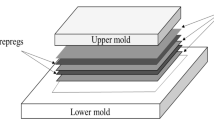Conclusions
-
1.
Fundamental laws governing the phenomenology of the perforation mechanics of composite materials in a polymer matrix are brought to light as a result of the complex experimental investigation that we conducted on basic parameters linking the perforation characteristics of metallic alloys and composite materials in the subcritical and post-critical velocity regions of high-speed impact.
-
2.
A new variant of the phenomenological relationship between Δv/vcr and ven/vcr is proposed and approved for comparative analysis of the ability of materials to resist perforating action. The existence of the continuity of this relationship for composite materials in the post-critical region is demonstrated in an example of fiberglasses and carbon-fiberreinforced plastics.
-
3.
The fact of significantly higher indicators of the ability of glass mats to resist erforating action as compared with corresponding polymerized fiberglasses is, established for equal small ϱh values. The greater ability of glass-mat-base fiberglasses to resist perforation is observed for the higher perforation resistance of glass mats. The specific resistance of titanium alloys is somewhat higher than that of fiberglasses; the reverse effect is observed, however, for small and also extremely large ϱh values.
-
4.
As for metallic alloys, the perforation curves of composite materials in (h/d, (vcr/c)(ρpr/ρob)1/2) coordinates are straight lines, which form a beam, in the impact-velocity region under investigation.
-
5.
It is proposed to compare the residual-strength characteristics of the materials in objects after a high-speed impact event for equal values of the ratio ven/vcr. It is shown that fiberglass formed from T-10-80 fabric and epoxy binder ÉDT-10 is extremely sensitive from the standpoint of strength reduction to failure over the entire range of impact velocities in both the subcritical and post-critical regions, having observed the maximum softening in the vicinity of the critical velocity. After passing the critical velocity, the residual strength increases, emerging thereafter at a stationary level.
Similar content being viewed by others
Literature Cited
T. W. Ipson and R. F. Recht., “Ballastic-penetration, resistance and its measurement,” Exp. Mech.,15, No. 7, 249–257 (1975).
S. G. Mileiko and O. A. Sarkisyan, “Phenomenological perforation model,” Zh. Prikl. Mekh. Tekh. Fiz., No. 5, 17–19 (1981)
J. Awerbuch and H. T. Hohn, “Hard object impact damage of metal matrix composites,” J. Composite Mater.,10, 231–257 (1976).
S. F. Kondakov and O. A. Sarkisyan, “Effect of temperature on the perforation resistance of metallic objects,” Probl. Prochn., No. 9, 69–71 (1980).
M.L. Wilkins, Penetration Mechanics, UCRL-72111, University of California. Berkley Radiation Laboratory (1969), p. 40.
J. Awerbuch and S. R. Bodner, “Experimental investigation of normal perforation of projectiles in metallic plates,” Int. J. Solids Struct.,10, No. 6, 685–699 (1974).
S. T. Mileiko, S. F. Kondakov, and E. G. Golofast, “On one case of perforation,” Probl. Prochn., No. 12, 69–71 (1979).
M. L. Wilkins, “Mechanics of penetration and perforation,” Int. J. Eng. Sci.,16, No. 11, 793–807 (1978).
J. Gering, “High-Speed Impact from the Engineering Standpoint,” High-Speed Impact Phenomena [Russian translation], V. N. Nikolaevskii (ed.), Mir, Moscow (1973), pp. 468–517.
S. T. Mileiko, S. F. Kondakov, and O. A. Sarkisyan, “On the perforation of metallic objects by a spherical projectile,” Continuum Mechanics: Materials Presented at the All-Union Conference on Continuum Mechanics, May, 1979, Tashkent (1982), pp. 42–46.
G. Dorey and G. R. Sidey, “Residual strength of CFRP laminates after ballistic impact,” Mechanical Properties High Rates Strain. Proceedings of the Conference, Oxford et al., (1974), pp. 344–351.
V. P. Muzychenko and V. I. Postnov, Impact Mechanics of Systems Deformed through Heredity (Phenomenological Mechanics of Composite Perforation) [in Russian], Ya. Fabritsius DVVAIU, Daugavpils (1985), p. 206.
Additional information
Daugavpils. Kuibyshev. Translated from Problemy Prochnosti, No. 8, pp. 62–66, August, 1986.
Rights and permissions
About this article
Cite this article
Muzychenko, V.P., Postnov, V.I. Characteristic features of the phenomenology of the perforation of composite materials. Strength Mater 18, 1065–1070 (1986). https://doi.org/10.1007/BF01525354
Received:
Issue Date:
DOI: https://doi.org/10.1007/BF01525354




